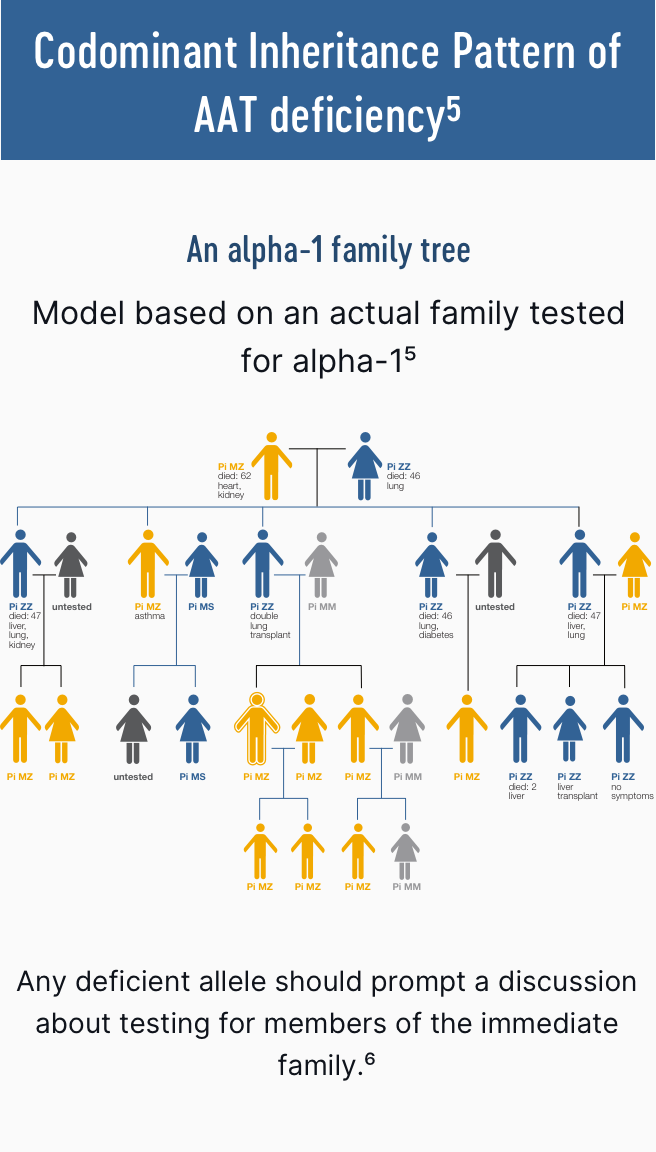Common genotypes of AAT deficiency
AAT deficiency is an autosomal codominant condition, so both copies of the inherited alleles are expressed.1,2 More than 150 different variants have been identified in the SERPINA1 gene.2 The normal version (allele) of the gene is termed M.1,2 The predominant alleles associated with AAT deficiency are the Z and S alleles, with Z by far the most common, accounting for ~95% of AAT deficiency cases.1,2
- The Z allele is associated with very low serum levels of AAT (~10%-15% of normal levels), and patients who are homozygous (ZZ) are at high risk of developing severe AAT deficiency1,2
- The S allele is associated with moderately low serum levels of AAT2,3
- Heterozygous patients with one S allele and one Z allele, (SZ), are also considered at increased risk for developing COPD, especially if they have ever smoked2,3
- Nearly 25 million Americans are thought to have at least 1 deficient allele (S or Z) that causes alpha-1 and may pass that gene on to their children4
Other rarer variants, called null variants, are associated with the complete absence of AAT protein in the bloodstream as none is produced.2,3
Summary of the most common genotypes, AAT serum levels, and risk for AAT deficiency3:
MM
- AAT Serum Level
-
Normal
- Risk of AAT deficiency
-
None to Low*
ZZ
- AAT Serum Level
-
Very Low
- Risk of AAT deficiency
-
High
MZ (carrier)
- AAT Serum Level
-
Moderate
- Risk of AAT deficiency
-
Low to Moderate
SZ
- AAT Serum Level
-
Low
- Risk of AAT deficiency
-
Moderate to High
Null
- AAT Serum Level
-
None
- Risk of AAT deficiency
-
High
| Inherited Genetic Variants | AAT Serum Level | Risk of AAT deficiency |
|---|---|---|
|
MM |
Normal |
None to Low* |
|
ZZ |
Very Low |
High |
|
MZ (carrier) |
Moderate |
Low to Moderate |
|
SZ |
Low |
Moderate to High |
|
Null |
None |
High |
Examine all the genetic variants detected by AlphaID™ by downloading the
AlphaID Alleles Guide
Alpha-1 prevalance and underdiagnosis
"It isn’t just that patient that you can see it, and they are of Irish descent…We need to look at it in all of our patients."
— Monica Goldklang, MD
Columbia University Irvine Medical Center

Up Next: Alpha-1 Screening Guidelines
PI, protease inhibitor.
References:
- Stoller JK, Aboussouan LS. A review of alpha-1 antitrypsin deficiency. Am J Respir Crit Care Med. 2012;185(3):246-259.
- National Organization for Rare Disorders. Alpha-1 antitrypsin deficiency. https://rarediseases.org/rare-diseases/alpha-1-antitrypsin-deficiency/. Accessed May 1, 2024.
- Silverman EK, Sandhaus RA. Clinical Practice. Alpha-1 antitrypsin deficiency. N Engl J Med. 2009;360(26):2749-2757.
- Miskoff JA, Khan B, Chaudhri M, Phan H, Carson MP. Identifying alpha-1 antitrypsin deficiency based on computed tomography evidence of emphysema. Cureus. Published online January 28, 2019. doi:10.7759/cureus.3971
- Data on file, Alpha-1 Genetics Laboratory, Grifols.
- American Thoracic Society/European Respiratory Society. American Thoracic Society/European Respiratory Society statement: standards for the diagnosis and management of individuals with alpha-1 antitrypsin deficiency. Am J Respir Crit Care Med. 2003;168(7):818-900.